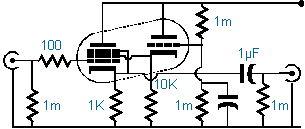Hi All,
I'm still exploring possibilities as far as a line stage goes. I started looking at cathode followers (since I don't really need any gain) to use as a buffer/volume control after my cd player. I came across a diagram of a proposed cathode follower using a pentode (6V6 is what I have in mind) but the screen 2 voltage is regulated (?) using a triode cathode follower (5687, I have lots of them)and taking the voltage off the Rk of the triode. I'm not ashamed to say that I'm not all that familiar with biasing cathode followers and this just makes the picture a little more fuzzy. I can do a little reading up and calculating but does the potential of this circuit justify the added complexity and work? Thanks.
I'm still exploring possibilities as far as a line stage goes. I started looking at cathode followers (since I don't really need any gain) to use as a buffer/volume control after my cd player. I came across a diagram of a proposed cathode follower using a pentode (6V6 is what I have in mind) but the screen 2 voltage is regulated (?) using a triode cathode follower (5687, I have lots of them)and taking the voltage off the Rk of the triode. I'm not ashamed to say that I'm not all that familiar with biasing cathode followers and this just makes the picture a little more fuzzy. I can do a little reading up and calculating but does the potential of this circuit justify the added complexity and work? Thanks.
Attachments
Hi Sy. It is held at a constant potential. The reference is the triodes cathode though. I just don't see the advantage of that though. The article can be found here:
http://www.glass-ware.com/tubecircuits/Easy_Cathode_Followers_2.html
http://www.glass-ware.com/tubecircuits/Easy_Cathode_Followers_2.html
Yes, it is held at a constant potential but you gain the same effect (minus 300 ohms or so series resistance due to the CF) by connecting screen to B+. And that means the pentode is in triode mode. To be in pentode mode, the screen must be held at a constant potential wrt. the cathode. But that's no problem, move that coupling cap from ground to cathode.
<Checks link>
Frankly, I can't believe a publication would actually say that! Their pentode is in triode, not pentode mode. All they did was give it a 1/2 B+ filtered supply.
Tim
<Checks link>
Frankly, I can't believe a publication would actually say that! Their pentode is in triode, not pentode mode. All they did was give it a 1/2 B+ filtered supply.
Tim
How about using an emitter follower:
http://www.diyaudio.com/forums/showthread.php?s=&threadid=10103&perpage=15&pagenumber=4
http://www.diyaudio.com/forums/showthread.php?s=&threadid=10103&perpage=15&pagenumber=4
An externally hosted image should be here but it was not working when we last tested it.
Dear all,
i've modified some values since i've designed this amplifier but the principle remain the same.
Best regards
A 10 y/o thread?
A pentode will not work as a CF/cathodyne unless the V2k is constant. Otherwise, you'll get UL type operation, and it won't be a true pentode. That means capacitor coupling the screen and cathode. You can also power the screen with a floating screen supply connected between the cathode and screen. This was done when using pents to make wideband cathodynes for o'scope vertical deflection amps. This not only kept the screen voltages tracking the cathode voltage, it also insured that Ik= Ip since the screen current flowed through the separate floating supply.
The original Wiggins Circlotron likewise used pents as cathode followers. There, the screen and plate supplies were cross-connected. That way, as the cathode voltage increased on one side as it fell on the other, the respective screen voltages would follow since the signal voltage is in series with the DC voltage.
A pentode will not work as a CF/cathodyne unless the V2k is constant. Otherwise, you'll get UL type operation, and it won't be a true pentode. That means capacitor coupling the screen and cathode. You can also power the screen with a floating screen supply connected between the cathode and screen. This was done when using pents to make wideband cathodynes for o'scope vertical deflection amps. This not only kept the screen voltages tracking the cathode voltage, it also insured that Ik= Ip since the screen current flowed through the separate floating supply.
The original Wiggins Circlotron likewise used pents as cathode followers. There, the screen and plate supplies were cross-connected. That way, as the cathode voltage increased on one side as it fell on the other, the respective screen voltages would follow since the signal voltage is in series with the DC voltage.
- Status
- This old topic is closed. If you want to reopen this topic, contact a moderator using the "Report Post" button.
- Home
- Amplifiers
- Tubes / Valves
- Pentode cathode follower with regulated screen voltage?
